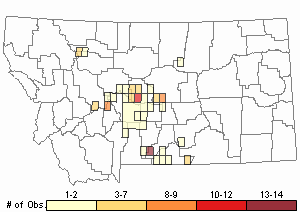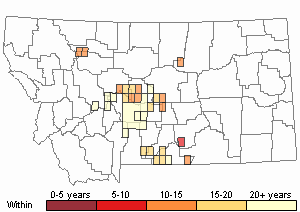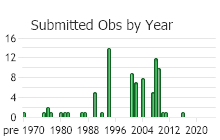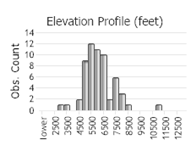View in other NatureServe Network Field Guides
NatureServe
Montana
Utah
Wyoming
Idaho
Wisconsin
British Columbia
South Carolina
Yukon
California
New York
Slender-lobed Clematis - Clematis columbiana var. tenuiloba
Other Names:
Clematis tenuiloba
Native Species
Global Rank:
G5?T4?Q
State Rank:
S3S4
(see State Rank Reason below)
C-value:
Agency Status
USFWS:
USFS:
BLM:
External Links
State Rank Reason (see State Rank above)
Clematis columbiana var. tenuiloba occurs in a variety of habitats, elevations, and disturbance regimes. Populations appear to be frequent and stable.
- Details on Status Ranking and Review
Population Size
ScoreU - Unknown
Range Extent
ScoreE - 5,000-20,000 sq km (~2,000-8,000 sq mi)
Area of Occupancy
ScoreE - 26-125 4-km2 grid cells
Number of Populations
ScoreC - 21 - 80
Number of Occurrences or Percent Area with Good Viability / Ecological Integrity
ScoreC - Few (4-12) occurrences with excellent or good viability or ecological integrity
Environmental Specificity
ScoreC - Moderate. Generalist or community with some key requirements scarce
Long-term Trend
ScoreU - Unknown
Trends
ScoreU - Unknown
Threats
ScoreU - Unknown
CommentThreats: Unknown/undetermined.
Intrinsic Vulnerability
ScoreC - Not intrinsically vulnerable
General Description
Clematis columbianaPlants: Stems viny, growing upward, clambering over surfaces or forming rhizomatous mats (Lesica 2012).
Leaves: Leaf blades 2- to 3-times ternate into lobed leaflets; leaflets 1–3 cm long, lanceolate (Lesica 2012), outlines varying, the lobes mostly deep, with serrate margins (FNA 1997).
Clematis columbiana variety
columbiana: Present in Montana.
Plants: Stems viny, growing upward, clambering over surfaces, 59-150(-350) cm in length (FNA 1997).
Leaves: Blade ternate 2 or 3 times, thin; leaflets typically lance-shaped or somewhat broader below with the several lobes usually more than 0.5 cm in width; margins toothed (FNA 1997).
Clematis columbiana variety
tenuiloba: Present in Montana.
Plants: Stems mostly rhizomatous and underground, those aboveground not viny, typically less than 10 cm in length (intermediate forms to var.
columbiana up to 150 cm), tufted (FNA 2005).
Leaves: Blade typically 3-ternate, somewhat fleshy; lobes usually 1.5-5 mm in width (FNA 1997).
(Lesica's contribution adapted from
Lesica et al. 2012. Manual of Montana Vascular Plants. BRIT Press. Fort Worth, TX)
Phenology
Clematis columbiana: Fruits mature late in the summer into autumn (Lesica 2012).
Clematis columbiana var.
columbiana: Flowers mostly spring into the first part of summer (upper elevations), but sometimes in autumn on young growth (FNA 1997).
Clematis columbiana var.
tenuiloba: Flowers late spring into the first part of summer (FNA 1997).
(P. Lesica's contribution adapted from
Lesica et al. 2012. Manual of Montana Vascular Plants. BRIT Press. Fort Worth, TX)
Diagnostic Characteristics
Clematis columbiana var.
columbiana: Stems clambering; the leaves only twice ternate (Lesica 2012), the blades thin, with final leaf divisions frequently greater than 5 mm in width (FNA 1997).
Clematis columbiana var.
tenuiloba: Stem tufted (not trailing or clambering); the leaves three-times ternate (Lesica 2012), the blades somewhat fleshy, with final leaf divisions usually 1.5-5 mm in width (FNA 1997).
(P. Lesica's contribution adapted from
Lesica et al. 2012. Manual of Montana Vascular Plants. BRIT Press. Fort Worth, TX)
Range Comments
Clematis columbiana: MT, ND south to AZ, NM, and TX (Lesica 2012).
Clematis columbiana var. columbiana: AZ, CO, ID, MT, NM, TX, UT, and WY. Elevation: 5580-10,500 feet (FNA 1997).
Clematis columbiana var. tenuiloba: CO, MT, ND, SD, UT, and WY. Elevation: 3280-9850 feet (FNA 1997).
(P. Lesica's contribution adapted from Lesica et al. 2012. Manual of Montana Vascular Plants. BRIT Press. Fort Worth, TX)
Observations in Montana Natural Heritage Program Database
Number of Observations: 97
(Click on the following maps and charts to see full sized version)
Map Help and Descriptions
Relative Density

Recency



 (Observations spanning multiple months or years are excluded from time charts)
(Observations spanning multiple months or years are excluded from time charts)
Habitat
Clematis columbiana: Both varieties have a strong affinity to calcareous soil (Lesica 2012).
Clematis columbiana var.
columbiana: Rocky groves of small trees and shrubs, open woodlands (FNA 1997).
Clematis columbiana var.
tenuiloba: Rock faces and peaks, typically in exposed areas or thin pine woodlands (FNA 1997).
(P. Lesica's contribution adapted from
Lesica et al. 2012. Manual of Montana Vascular Plants. BRIT Press. Fort Worth, TX)
Ecology
In their extremes, the 2 varieties appear markedly different. However, they intergrade considerably. Their physical form may be partially due to a response to their environment. For example, in some areas where variety
tenuiloba lives on wide-open crests, variety
columbiana may grow close by but at lesser elevations (FNA 1997).
POLLINATORS The following animal species have been reported as pollinators of this plant species or its genus where their geographic ranges overlap:
Bombus vagans,
Bombus occidentalis,
Bombus pensylvanicus, and
Bombus impatiens (Thorp et al. 1983, Colla and Dumesh 2010).
Reproductive Characteristics
Clematis columbianaFlowers: Bell-shaped, perfect, solitary, terminal, nodding; sepals 2.5–4 cm long, deep blue (Lesica 2012), rarely white in var.
columbiana, ovate or more lance-shaped (FNA 1997); petals lacking; stamens many; pistils many in a head-shaped (capitate) bundle (Hitchcock et al. 1964).
Fruit: Achene with feathery persistent style or beak (Hitchcock et al. 1964); beak 2–5 cm long (Lesica 2012).
Clematis columbiana variety
columbianaFlowers: Sepals 25-60 mm in length, violet or bluish-violet (FNA 1997).
Clematis columbiana variety
tenuilobaFlowers: Sepals 15-50 mm in length, violet or bluish-violet (FNA 1997).
(P. Lesica's contribution adapted from
Lesica et al. 2012. Manual of Montana Vascular Plants. BRIT Press. Fort Worth, TX)
Management
ECONOMIC VALUE
Clematis columbiana: Leaves or sometimes leaves and stems are steeped, the liquid then washed into the hair to prevent greyness (Moerman 1998).
Clematis columbiana var. columbiana: Plants are cultivated for their beauty and to provide shade (Moerman 1998).
Stewardship Responsibility
References
- Literature Cited AboveLegend:
 View Online Publication
View Online Publication Colla, S.R. and S. Dumesh. 2010. The bumble bees of southern Ontario: notes on natural history and distribution. Journal of the Entomological Society of Ontario 141:39-68.
Colla, S.R. and S. Dumesh. 2010. The bumble bees of southern Ontario: notes on natural history and distribution. Journal of the Entomological Society of Ontario 141:39-68. Flora of North America Editorial Committee. 1997. Flora of North America North of Mexico. Volume 3. Magnoliophyta: Magnoliidae and Hamamelidae. Oxford University Press, Inc., New York, NY. xxiii + 590 pp.
Flora of North America Editorial Committee. 1997. Flora of North America North of Mexico. Volume 3. Magnoliophyta: Magnoliidae and Hamamelidae. Oxford University Press, Inc., New York, NY. xxiii + 590 pp. Hitchcock, C. L., A. Cronquist, M. Ownbey, and J. W. Thompson. 1964. Vascular Plants of the Pacific Northwest. Part 2: Salicaceae to Saxifragaceae. University of Washington Press, Seattle. 597 pp.
Hitchcock, C. L., A. Cronquist, M. Ownbey, and J. W. Thompson. 1964. Vascular Plants of the Pacific Northwest. Part 2: Salicaceae to Saxifragaceae. University of Washington Press, Seattle. 597 pp. Lesica, P., M.T. Lavin, and P.F. Stickney. 2012. Manual of Montana Vascular Plants. Fort Worth, TX: BRIT Press. viii + 771 p.
Lesica, P., M.T. Lavin, and P.F. Stickney. 2012. Manual of Montana Vascular Plants. Fort Worth, TX: BRIT Press. viii + 771 p. Moerman, D.E. 1998. Native American ethnobotany. Portland, OR: Timber Press, Inc. 927 p.
Moerman, D.E. 1998. Native American ethnobotany. Portland, OR: Timber Press, Inc. 927 p. Thorp, R.W., D.S. Horning, and L.L. Dunning. 1983. Bumble bees and cuckoo bumble bees of California (Hymenoptera: Apidae). Bulletin of the California Insect Survey 23:1-79.
Thorp, R.W., D.S. Horning, and L.L. Dunning. 1983. Bumble bees and cuckoo bumble bees of California (Hymenoptera: Apidae). Bulletin of the California Insect Survey 23:1-79.
- Additional ReferencesLegend:
 View Online Publication
View Online Publication
Do you know of a citation we're missing? King, C. R. 1953. The Ranunculaceae of Montana. M.S. Thesis, Bozeman, MT: Montana State College. 82 p.
King, C. R. 1953. The Ranunculaceae of Montana. M.S. Thesis, Bozeman, MT: Montana State College. 82 p. Lesica, P., M.T. Lavin, and P.F. Stickney. 2022. Manual of Montana Vascular Plants, Second Edition. Fort Worth, TX: BRIT Press. viii + 779 p.
Lesica, P., M.T. Lavin, and P.F. Stickney. 2022. Manual of Montana Vascular Plants, Second Edition. Fort Worth, TX: BRIT Press. viii + 779 p. Saunders, J.K. Jr. 1955. Food habits and range use of the Rocky Mountain goat in the Crazy Mountains, Montana. Journal of Wildlife Management 19(4):429-437.
Saunders, J.K. Jr. 1955. Food habits and range use of the Rocky Mountain goat in the Crazy Mountains, Montana. Journal of Wildlife Management 19(4):429-437. Saunders, J.K., Jr. 1954. A two-year investigation of the food habits and range use of the Rocky Mountain goat in the Crazy Mountains, Montana. M.Sc. Thesis. Bozeman, MT: Montana State University. 22 p.
Saunders, J.K., Jr. 1954. A two-year investigation of the food habits and range use of the Rocky Mountain goat in the Crazy Mountains, Montana. M.Sc. Thesis. Bozeman, MT: Montana State University. 22 p.
- Web Search Engines for Articles on "Slender-lobed Clematis"





